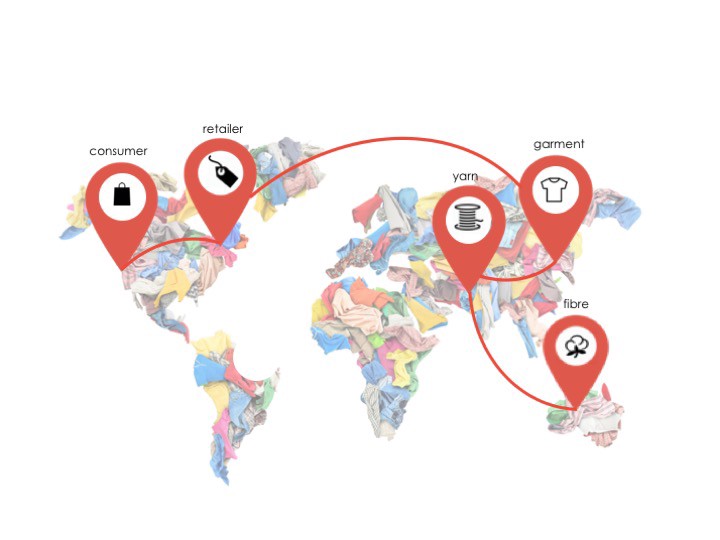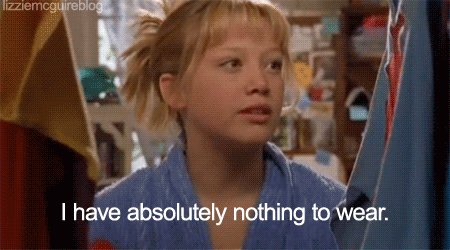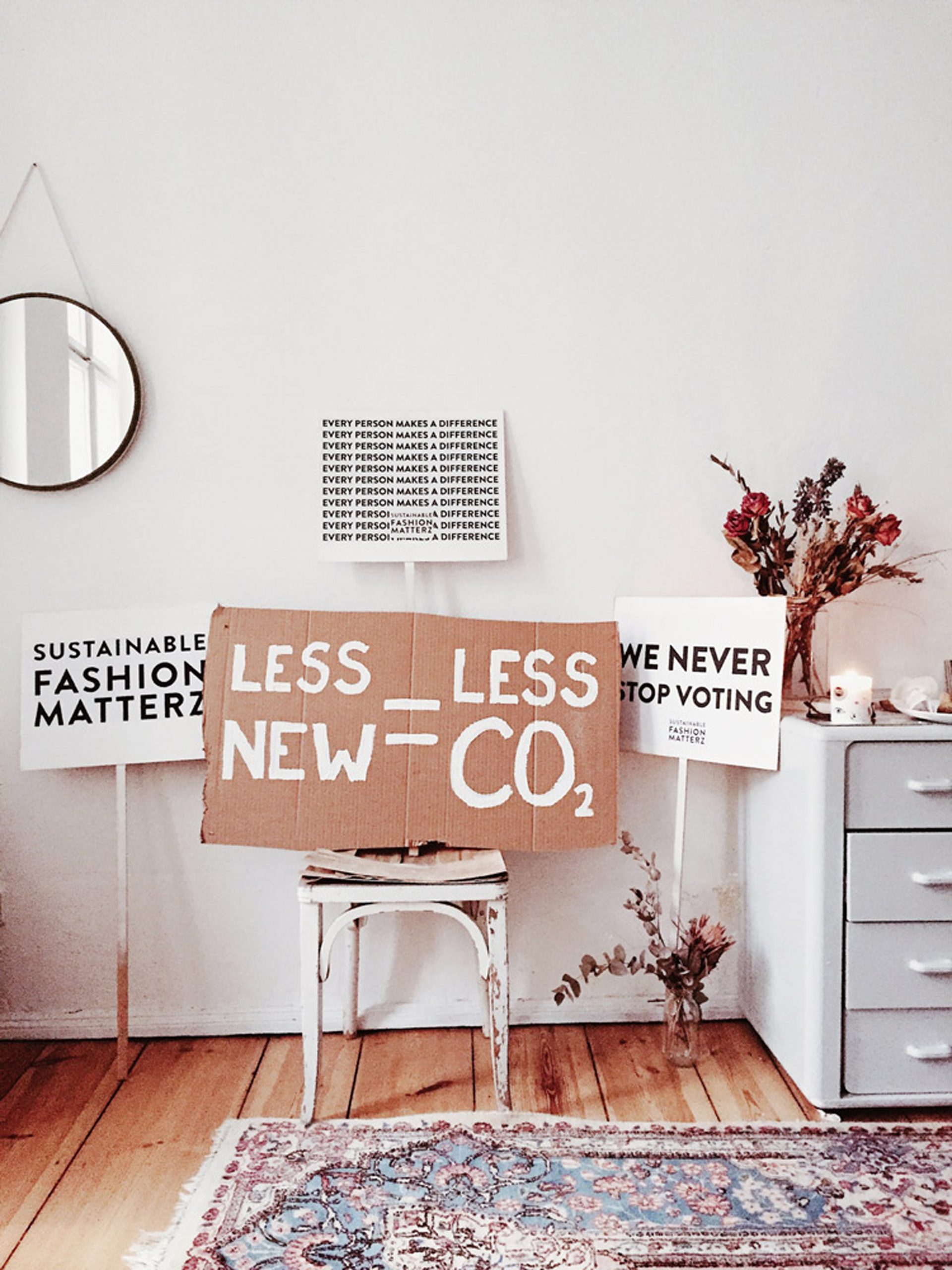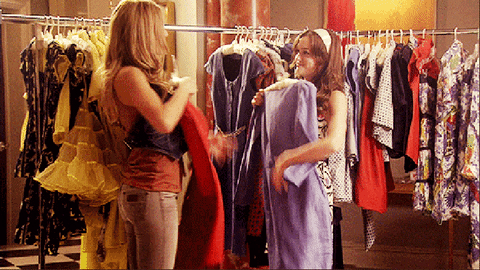Every day we get up and get dressed. Let me tell you about the journey your clothes have taken. The fashion supply chain is global and comprises of growing natural or manufacturing synthetic fibre in one location, which is then spun into yarn, woven into a textile, cut and assembled into a garment, and then sold through a retailer to us.

Fashion plays an integral part in our everyday life and is also a multi-trillion dollar global business. Fashion supply chains are long and complex — and our clothes cross many oceans and hands before it ends up on our back. Now we might not think about all this when we go shopping. We have to wear clothes and usually, our shopping process is to look for what is available in the style, colour and brand we like. Then we think: Does it look good? Does it fit? Can I afford it? Sold!
So what’s the problem?
There are environmental and social implications for every fibre choice and at every stage of production. Starting with the fibre stage, the majority of our clothing is made from synthetics such as polyester, which is derived from fossil fuels — a non-renewable resource and it also takes up to 200 years to biodegrade. Cotton is the most used natural fibre and it has been scrutinised for its use of water and pesticides, as well as labour practices. Then at the manufacturing stage, water, chemicals and lots of energy are used to dye textiles. Textiles are then cut into various shapes and sewn together to make a garment causing around 60 billion square metres of waste from offcuts per year. Most of our clothing is made in low-cost factories in developing countries, where there have been many recorded instances of child labour, forced labour and underpayment and unsafe working conditions.
Then after we purchase our clothing, we use a lot of water to launder them. Here they shed microfibres which goes into our waterways and marine life. And then what happens when we are finished wearing our clothing? If they are still in good condition we can donate them to a second-hand retailer and charity or give them to a friend. But if it’s unsaleable then it might be turned to rags or go straight to landfill. Textile recycling is still a fairly new technology and only 1% of clothing has been recycled back into fibre for textiles. Added to this is the rise of cheap low-quality fast-fashion over the last 20 years — we now own more clothing but wear it less and disposing of them more.
What is sustainable fashion?
So, let us just take a pause for a minute because that is a lot to take in and you’re probably wondering if there such a thing as sustainable fashion?
Well, yes and no. Sustainable fashion is a thing and it could be defined as apparel that has little to no negative impact on its workers and the environment, designed for longevity and incorporates elements of recycling or makes use of existing materials. Sustainable fashion is also used as an umbrella term to describe ethical fashion (human rights), eco fashion (environmentally conscious), slow fashion (buying less) and circular fashion (using existing items). You can find a list of terms here and here — have fun, there is a few. But as it stands between fashions long, complex supply chain and the frequency in which new clothing is made, sustainability at each point of the fashion supply chain is really difficult to achieve at scale.
 So what are brands doing? Brands talk about their sustainability mission through Corporate Social Responsibility reports, signing up to sourcing sustainable materials and other initiatives, trying to quantify and understand their impact, and basically doing their best to be more sustainable and less bad. But, let me be very clear here: there is still a long way to go. Let’s take Zara as an example: a fast-fashion giant who drops collections every two weeks, announced last June that 100% of their fabrics will be sustainable by 2025. But do they have any intention of reducing the sheer volume of garments they pump out annually? Probably not. Sourcing ‘more sustainable’ fabric is important, but it is not sustainable if brands are still producing in massive quantities. Remember, a key problem with the fashion system is that there are too many clothes and as it stands, the approach of being ‘more sustainable’ does not include producing less.
So what are brands doing? Brands talk about their sustainability mission through Corporate Social Responsibility reports, signing up to sourcing sustainable materials and other initiatives, trying to quantify and understand their impact, and basically doing their best to be more sustainable and less bad. But, let me be very clear here: there is still a long way to go. Let’s take Zara as an example: a fast-fashion giant who drops collections every two weeks, announced last June that 100% of their fabrics will be sustainable by 2025. But do they have any intention of reducing the sheer volume of garments they pump out annually? Probably not. Sourcing ‘more sustainable’ fabric is important, but it is not sustainable if brands are still producing in massive quantities. Remember, a key problem with the fashion system is that there are too many clothes and as it stands, the approach of being ‘more sustainable’ does not include producing less.
What can you do?
So far, we have established that we need to wear clothing, we buy what is available, some brands are trying to be ‘more sustainable and less bad’ but every product has an impact and we are still producing more clothing. Now you might be thinking, most of these impacts are happening before you even buy the product. So what can I do about this?
And you are right. How do we know if our clothing has been made ethically or environmentally friendly? It can be hard to know. Often we see sustainable fashion as inaccessible, out of our price range, hard to find information about and compare — it can get really confusing.
At this point, I want to be clear: I am not saying you have to stop buying things, throw away your entire wardrobe or buy expensive clothes. I’m saying now that you’re aware, you can be conscious about what you buy and wear. Consumer spending sends a really powerful message to retailers about what we care about. If we start buying clothing that is ‘more sustainably’ made, retailers must pivot to meet this demand or they will lose customers. Change needs to happen at both the retail level and how we value our clothing, and we can pledge our support to retailers who are taking action with our dollars. So, get ready because here are five ways you can take action.
 1.Find brands that you trust. You can see what brands are doing about their impact by looking at helpful guides. Check out Britts List and the Good on You app. Certifications are one way to identify if a product has met an ethical or environmental standard, and it is usually verified by a third, independent party. You can also support local designers where possible instead of big multi-national companies. In Brisbane, we have a great local community of thoughtful and sustainably-minded designers and practitioners, such as Practice Studio in Fortitude Valley and Open House in West End.
1.Find brands that you trust. You can see what brands are doing about their impact by looking at helpful guides. Check out Britts List and the Good on You app. Certifications are one way to identify if a product has met an ethical or environmental standard, and it is usually verified by a third, independent party. You can also support local designers where possible instead of big multi-national companies. In Brisbane, we have a great local community of thoughtful and sustainably-minded designers and practitioners, such as Practice Studio in Fortitude Valley and Open House in West End.
2.We can also buy less — quality over quantity. Ask yourself: Will I wear it? Do I own something similar? How long will it last?
3.We can extend the lifespan of garments that already exist through buying secondhand, check out SWOP at West End and Brisbane City, Lydia’s at Red Hill near QUT Kelvin Grove (I have found absolute gems here: a Scanlan Theodore anorak jacket for $25 — sign. me. up!). You can also search eBay and Facebook market place for brands you love. Got old clothes and not sure if you can donate them? Here is a decision tree to help with that. For special occasions try borrowing from friends or renting from sites such as GlamCorner.
We can also repair, renew and reuse our clothing wherever possible. Here is a little activity for you: Learn how to sew buttons and fix tears or locate your closest alternations place.
 Okay, I think we can all relate to this. Wearing the same clothes all the time can get a bit boring and we can feel the need to buy something new to give us a little spring in our step. But the best thing we can do is wear what we’ve already got! Check out @penelope_bell_official ‘Consciously Spending Less to Create More’ (CSLTCM) project where she challenges herself to get more wear out of her clothes by being a little creative.
Okay, I think we can all relate to this. Wearing the same clothes all the time can get a bit boring and we can feel the need to buy something new to give us a little spring in our step. But the best thing we can do is wear what we’ve already got! Check out @penelope_bell_official ‘Consciously Spending Less to Create More’ (CSLTCM) project where she challenges herself to get more wear out of her clothes by being a little creative.
4.We can launder garments less which will make our clothes last longer and also save water (double points here!). But to avoid an awkward BO situation let your clothes air-dry between wears and get an odour neutraliser spray. However, in tropical Queensland, this can be hard to do during summer. Opt for natural fibres such as wool which are naturally odour resistant (and yes, you can wear wool in summer).
5.Alrighty, if you’ve made it this far and you’re keen to know more you can research, read and listen about fashion and sustainability — be engaged. There are some great podcasts if that’s your thing (Wardrobe Crisis by Clare Press), heaps of books (there is a list here), follow movements (Fashion Revolution, Worlds Biggest Garage Sale), documentaries (True Cost) and read some aesthetically pleasing but damning reports (State of Fashion, Baptist World Aid, Pulse of Fashion, Ellen McArthur).
Where to from here?
I hope that what you take away from all of this is that the fashion industry plays a big role in our day to day lives and that every step, from raw materials to processing, transport, consumer use, and end of life disposal has an impact on our planet and people. The part we can control as consumers is what we chose to buy and wear. I spoke about five actions we can take to be more sustainable consumers:
I hope this article has opened your eyes to different (and fun) ways to engage with fashion more sustainably, and how you can play a part in the change that is needed.
This article was written as an educational piece for students at Queensland University of Technology as part of Sustainability Week (September 7–11, 2020).
About the author: Zoe Mellick is a final year PhD candidate in Creative Industries at the Queensland University of Technology in Brisbane, Australia. Her research looks at how people’s perspectives around the value of sustainability in fashion supply chains are critical to improving how our clothing is made. Views expressed in this article are her own.








